Strengthening Cracked Steel Plates with Shape Memory Alloy Patches: Numerical and Experimental Investigations
Abstract
:1. Introduction
2. CT Model-Based Feasibility Analysis
2.1. Finite Element Model
2.2. Simulation of Different Fatigue Types
2.3. Variation in the SIFs
3. Parametric Analyses on the Strengthening Method
3.1. Effect of the Bonding Area
3.2. Effect of the Thickness of the SMA Patch
3.3. Effect of the Strengthening Angle
4. Experimental Investigations
4.1. Specimens and Fe-SMA Patches
4.2. Activation of the Fe-SMA Patch
4.3. Fatigue Test Setup
5. Test Results and Discussions
5.1. Strain Variation during Fatigue Testing
5.2. Crack Propagation
5.3. Fracture Surface Analysis
6. Conclusions
- (1)
- Bonding the SMA patch is applicable to the mode Ⅰ crack while inapplicable to both mode Ⅱ and mode Ⅲ cracks. Compared to the strengthening method by bonding the steel patch, bonding the SMA patch could further decrease the SIF at the crack tip because of the prestress force (i.e., the recovery force).
- (2)
- The SIF has decreased 144.2 MPa·mm1/2 in the presence of every 1 mm thickening of the SMA patch. It is recommended that the SMA patch be arranged with the direction of the recovery force perpendicular to the possible crack propagation direction. Comparatively, the reinforcement effect is less affected by the bonding area of the SMA patch.
- (3)
- Experimental results demonstrate the retarding effect on the crack growth by bonding the SMA patches. Compared with the bare steel plate, the fatigue life of SMA patch-strengthened specimens has increased by 188.9% and 168.3%, respectively. However, the retarding effect could be neglected when the fatigue crack propagates out the cover range of the SMA patch.
Author Contributions
Funding
Institutional Review Board Statement
Informed Consent Statement
Data Availability Statement
Conflicts of Interest
Nomenclature
| SMA | shape memory alloy |
| CT | compact tension |
| CFRP | carbon fiber reinforced polymer |
| GFRP | glass fiber reinforced polymer |
| SIF | stress intensity factor |
| FE | finite element |
| XFEM | extended finite element method |
References
- Fustar, B.; Lukacevic, I.; Dujmovic, D. Review of fatigue assessment methods for welded steel structures. Adv. Struct. Eng. 2018, 2018, 3597356. [Google Scholar]
- Wang, J.Q.; Xiong, Y.K.; Li, Q.; Jin, D.Z.; Hu, Y.Y.; Che, T.K. Experimental investigation on the preparation and surface treatment of biomass fibers for stone mastic asphalt mixtures modification. Constr. Build. Mater. 2023, 408, 133667. [Google Scholar] [CrossRef]
- Murdani, A.; Makabe, C.; Saimoto, A.; Irei, Y.; Miyazaki, T. Stress concentration at stop-drilled holes and additional holes. Eng. Fail. Anal. 2008, 15, 810–819. [Google Scholar] [CrossRef]
- Fang, L.; Fu, Z.Q.; Ji, B.H.; Wang, Q.D. Interference of cracking and drilling on opposite side of steel deck components. J. Constr. Steel Res. 2023, 208, 107996. [Google Scholar] [CrossRef]
- Liu, Q.; Chen, S.L.; Xu, X.W.; Jin, S.Y.; Li, Y.P.; Wang, Y.Q.; Shen, B. Multi-objective optimization of the subsurface residual stress field of TC4 alloy in machine hammer peening. J. Manuf. Process. 2023, 104, 98–107. [Google Scholar] [CrossRef]
- YuanZhou, Z.Y.; Ji, B.H.; Fu, Z.Q.; Kainuma, S.; Tsukamoto, S. Fatigue crack retrofitting by closing crack surface. Int. J. Fatigue 2019, 119, 229–237. [Google Scholar] [CrossRef]
- Li, A.B.; Xu, S.H.; Wang, Y.D.; Wu, C.; Nie, B. Fatigue behavior of corroded steel plates strengthened with CFRP plates. Constr. Build. Mater. 2021, 314, 125707. [Google Scholar] [CrossRef]
- Bu, L.T.; Hou, Q.; Zhou, J. Mechanical behaviour of H-shaped steel columns reinforced with bonded steel plates and anchor bolts. Structures 2023, 51, 544–559. [Google Scholar] [CrossRef]
- Duan, M.J.; Tang, Y.; Wang, Y.S.; Wei, Y.; Wang, J.Q. Compressive performance of longitudinal steel-FRP composite bars in concrete cylinders confined by different type of FRP composites. Polymers 2023, 20, 4051. [Google Scholar] [CrossRef]
- Liu, J.; Guo, T.; Wei, Y.; Wang, L.B.; Zou, X.X. Investigation of the effect of pre-tightening forces on bolted connection for FRP-steel joints. Case Stud. Constr. Mater. 2023, 19, 02348. [Google Scholar] [CrossRef]
- Miao, K.T.; Wei, Y.; Zheng, K.Q.; Zhang, S.C. Eccentric compression behavior of concrete-filled steel tube columns strengthened by CFRP/steel strip. Eng. Struct. 2023, 287, 116191. [Google Scholar] [CrossRef]
- Zareie, S.; Issa, A.S.; Seethaler, R.J.; Zabihollah, A. Recent advances in the application of shape memory alloys in civil infrastructures: A review. Structures 2020, 27, 1535–1550. [Google Scholar] [CrossRef]
- Muntasir, B.; Raham, J.; Zhang, Q. Shape memory alloys (SMAs) for resilient bridges: A state-of-the-art review. Structures 2022, 37, 514–527. [Google Scholar] [CrossRef]
- Fritsch, E.; Izadi, M.; Ghafoori, E. Development of nail-anchor strengthening system with iron-based shape memory alloy (Fe-SMA) strips. Constr. Build. Mater. 2019, 229, 117042. [Google Scholar] [CrossRef]
- Ghafoori, E.; Hosseini, E.; Leinenbach, C.; Michels, J.; Motavalli, M. Fatigue behavior of a Fe-Mn-Si shape memory alloy used for prestressed strengthening. Mater. Des. 2017, 133, 349–362. [Google Scholar] [CrossRef]
- Wang, W.D.; Li, L.Z.; Hosseini, A.; Ghafoori, E. Novel fatigue strengthening solution for metallic structures using adhesively bonded Fe-SMA strips: A proof of concept study. Int. J. Fatigue 2021, 148, 106237. [Google Scholar] [CrossRef]
- Izadi, M.R.; Ghafoori, E.; Motavalli, M.; Maalek, S. Iron-based shape memory alloy for the fatigue strengthening of cracked steel plates: Effects of re-activations and loading frequencies. Eng. Struct. 2018, 176, 953–967. [Google Scholar] [CrossRef]
- Chen, Z.Y.; Gu, X.L.; Zhao, X.L.; Ghafoori, E.; Yu, Q.Q. Fatigue tests on Fe-SMA strengthened steel plates considering thermal effects. J. Struct. Eng. 2023, 149, 04022255. [Google Scholar] [CrossRef]
- Wang, S.Z.; Li, L.Z.; Su, Q.T.; Jiang, X.; Ghafoori, E. Strengthening of steel beams with adhesively bonded memory-steel strips. Thin-Walled Struct. 2023, 189, 110901. [Google Scholar] [CrossRef]
- Vujtech, J.; Ryjacek, P.; Matos, J.C.; Ghafoori, E. Iron-Based shape memory alloy for strengthening of 113-Year bridge. Eng. Struct. 2021, 248, 113231. [Google Scholar] [CrossRef]
- Li, L.Z.; Wang, W.D.; Chatzi, E.; Ghafoori, E. Experimental investigation on debonding behavior of Fe-SMA-to-steel joints. Constr. Build. Mater. 2022, 364, 129857. [Google Scholar] [CrossRef]
- Qiang, X.H.; Wu, Y.P.; Jiang, X.; Xu, G.W. Fatigue performance of cracked diaphragm cutouts in steel bridge reinforced employing CFRP/SMA. J. Constr. Steel Res. 2023, 211, 108136. [Google Scholar] [CrossRef]
- Deng, J.; Fei, Z.Y.; Li, J.H.; Huang, H.F. Flexural capacity enhancing of notched steel beams by combining shape memory alloy wires and carbon fiber-reinforced polymer sheets. Adv. Struct. Eng. 2023, 26, 1525–1537. [Google Scholar] [CrossRef]
- Kean, V.; Chen, T.; Li, L.Z. Numerical study of fatigue life of SMA/CFRP patches retrofitted to central-cracked steel plates. Constr. Build. Mater. 2021, 284, 122845. [Google Scholar] [CrossRef]
- Zheng, B.T.; El-Tahan, M.; Dawood, M. Shape memory alloy-carbon fiber reinforced polymer system for strengthening fatigue-sensitive metallic structures. Eng. Struct. 2018, 171, 190–201. [Google Scholar] [CrossRef]
- Russian, O.; Belarbi, A.; Dawood, M. Effect of surface preparation technique on fatigue performance of steel structures repaired with self-stressing SMA/CFRP patch. Compos. Struct. 2021, 280, 114968. [Google Scholar] [CrossRef]
- Izadi, M.R.; Ghafoori, E.; Shahverdi, M.; Motavalli, M.; Maalek, S. Development-of an iron-based shape memory alloy (Fe-SMA) strengthening system for steel plates. Eng. Struct. 2018, 174, 433–446. [Google Scholar] [CrossRef]
- ASTM E21-09; Standard Test Methods for Elevated Temperature Tension Tests of Metallic Materials. ASTM International: West Conshohocken, PA, USA, 2009.
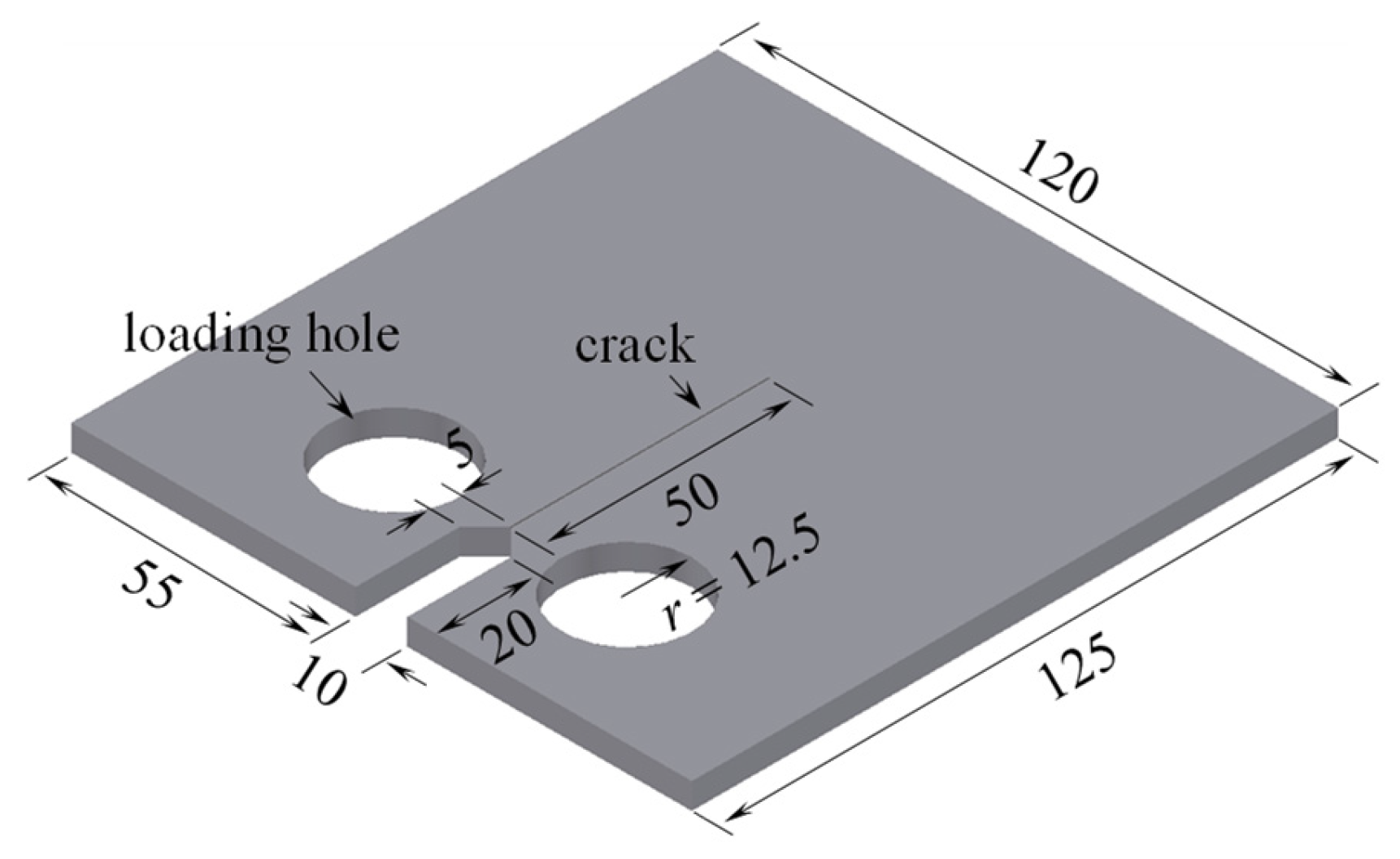


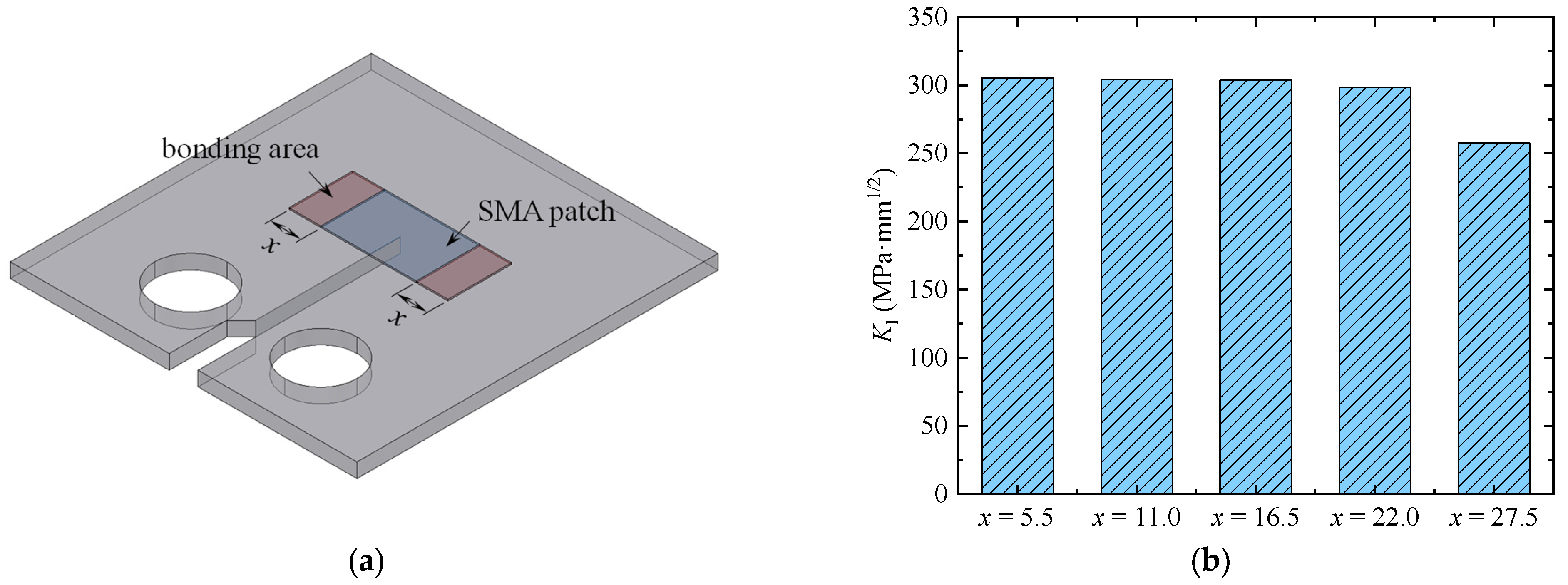
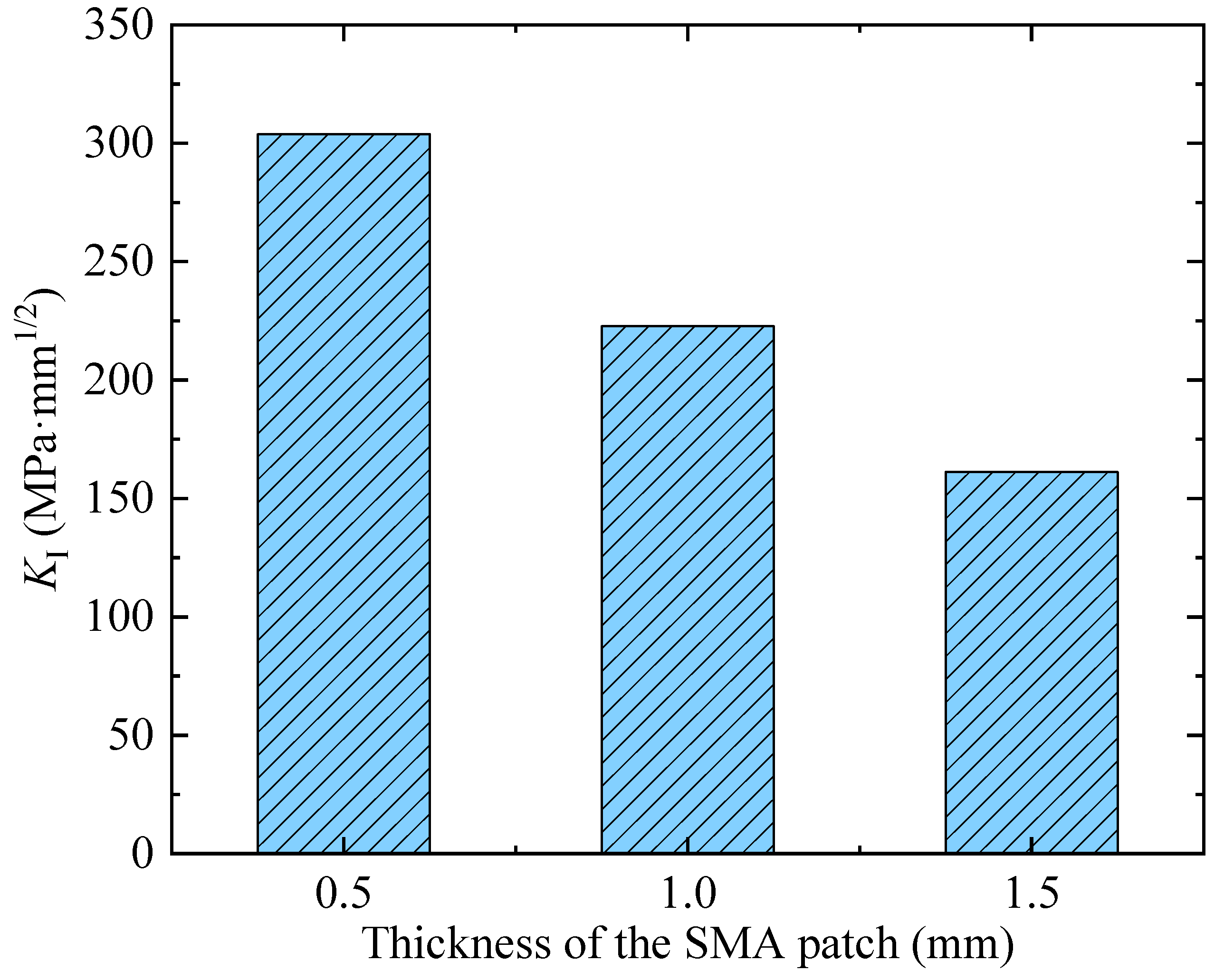
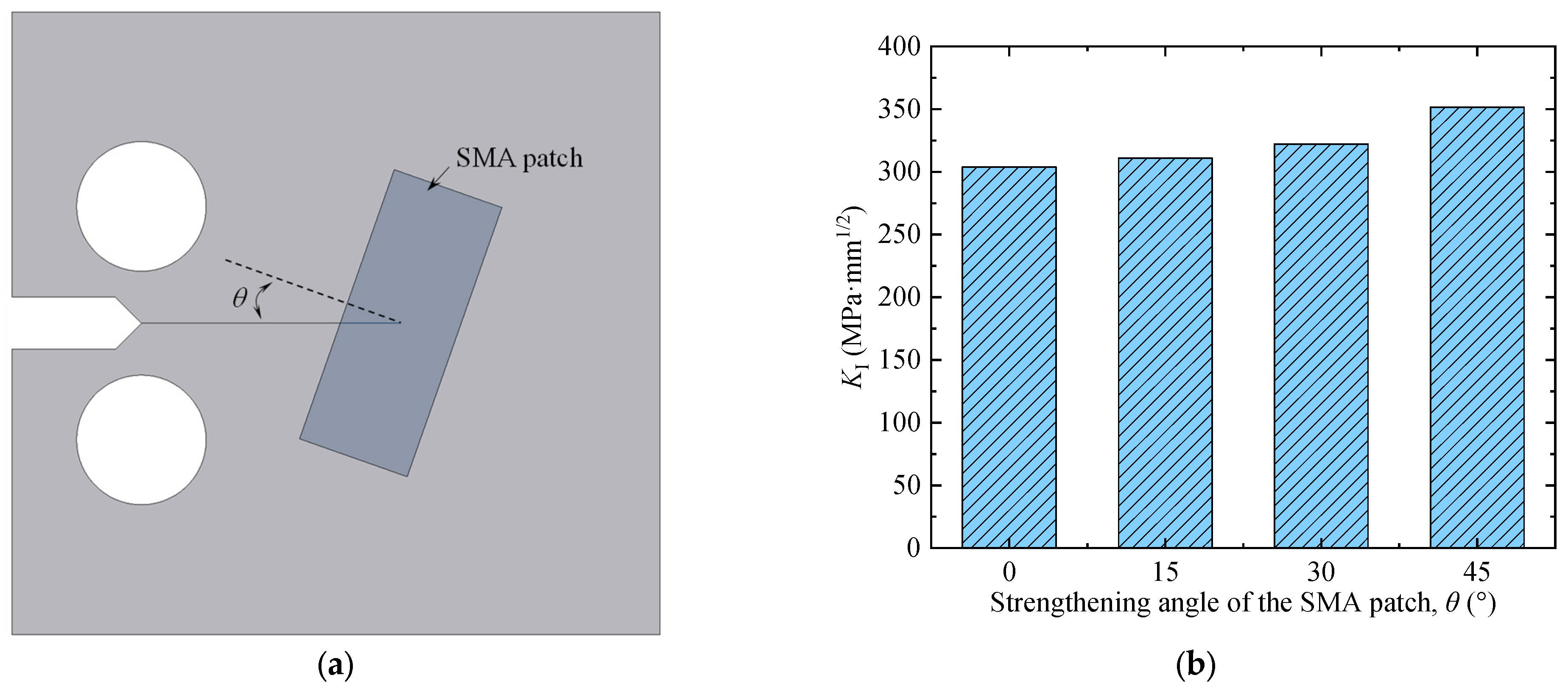
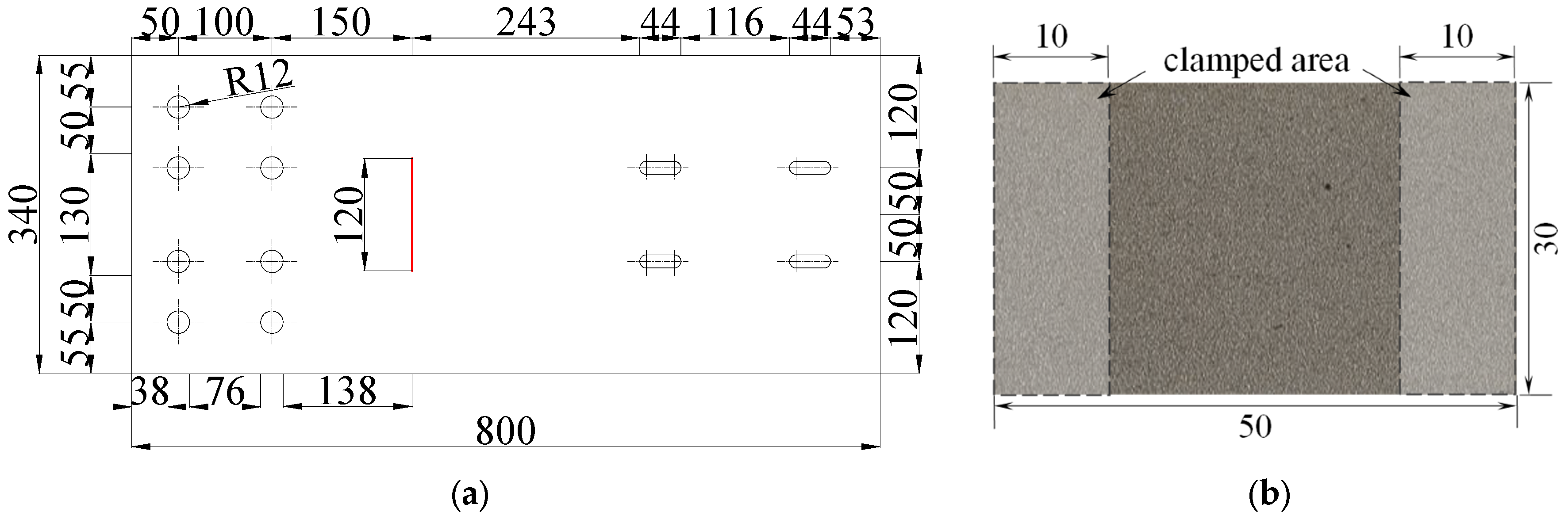
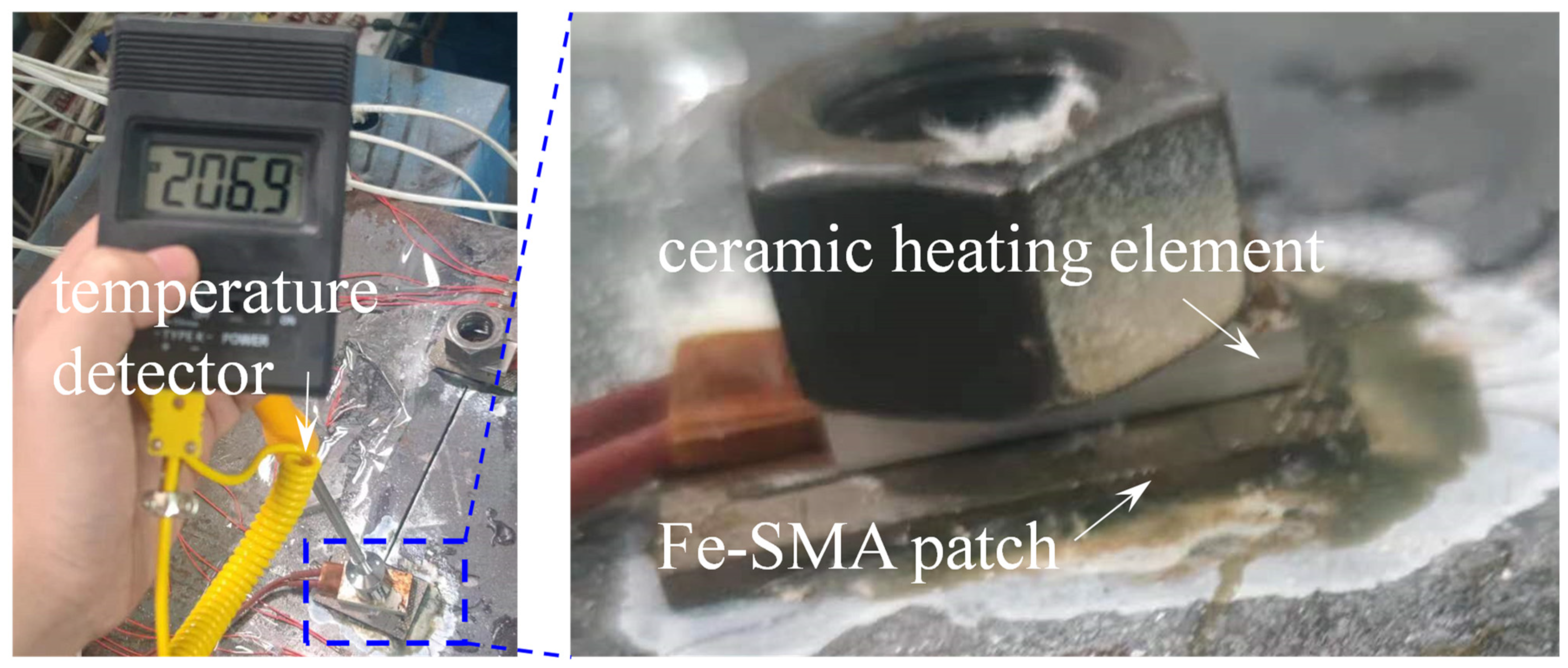
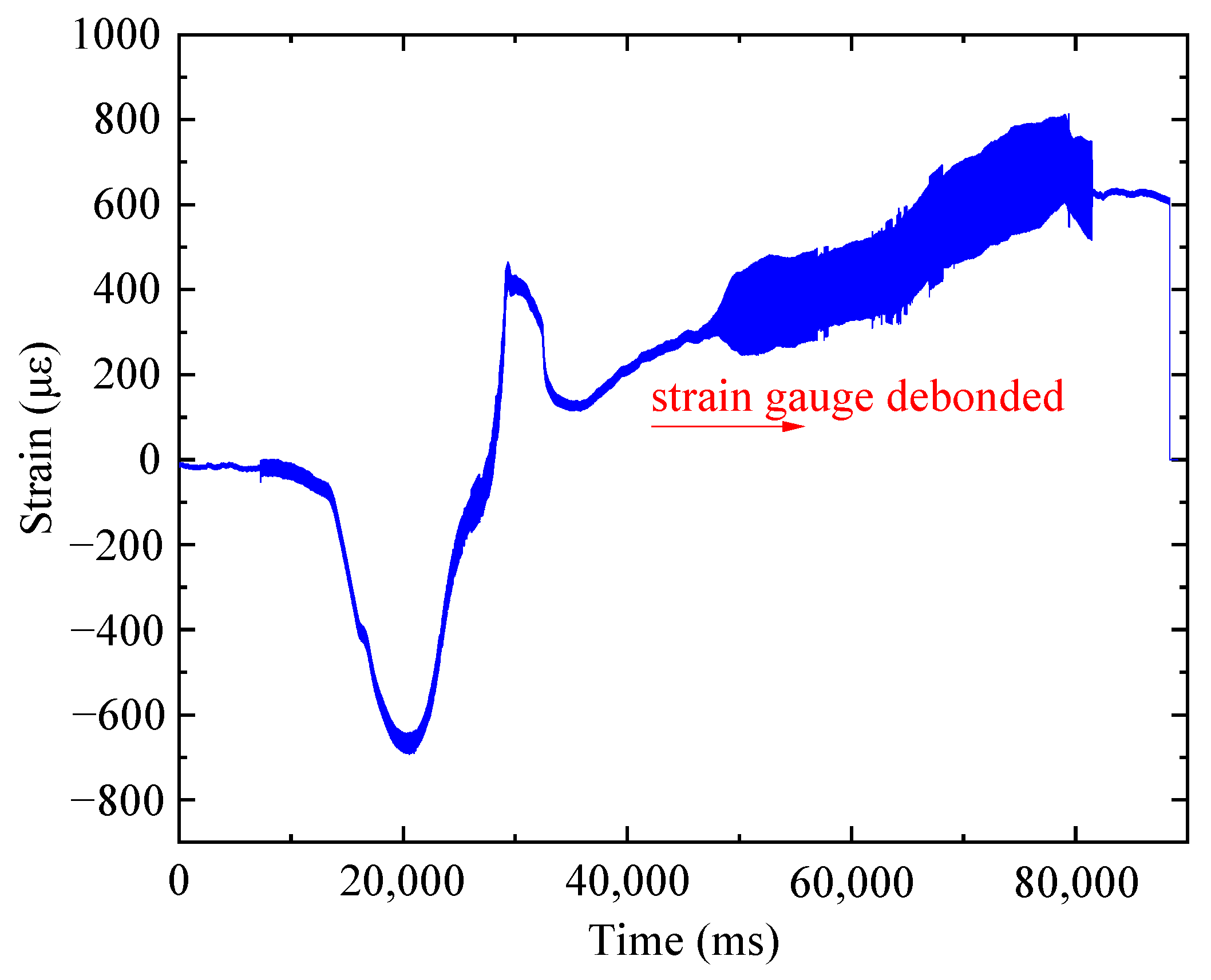

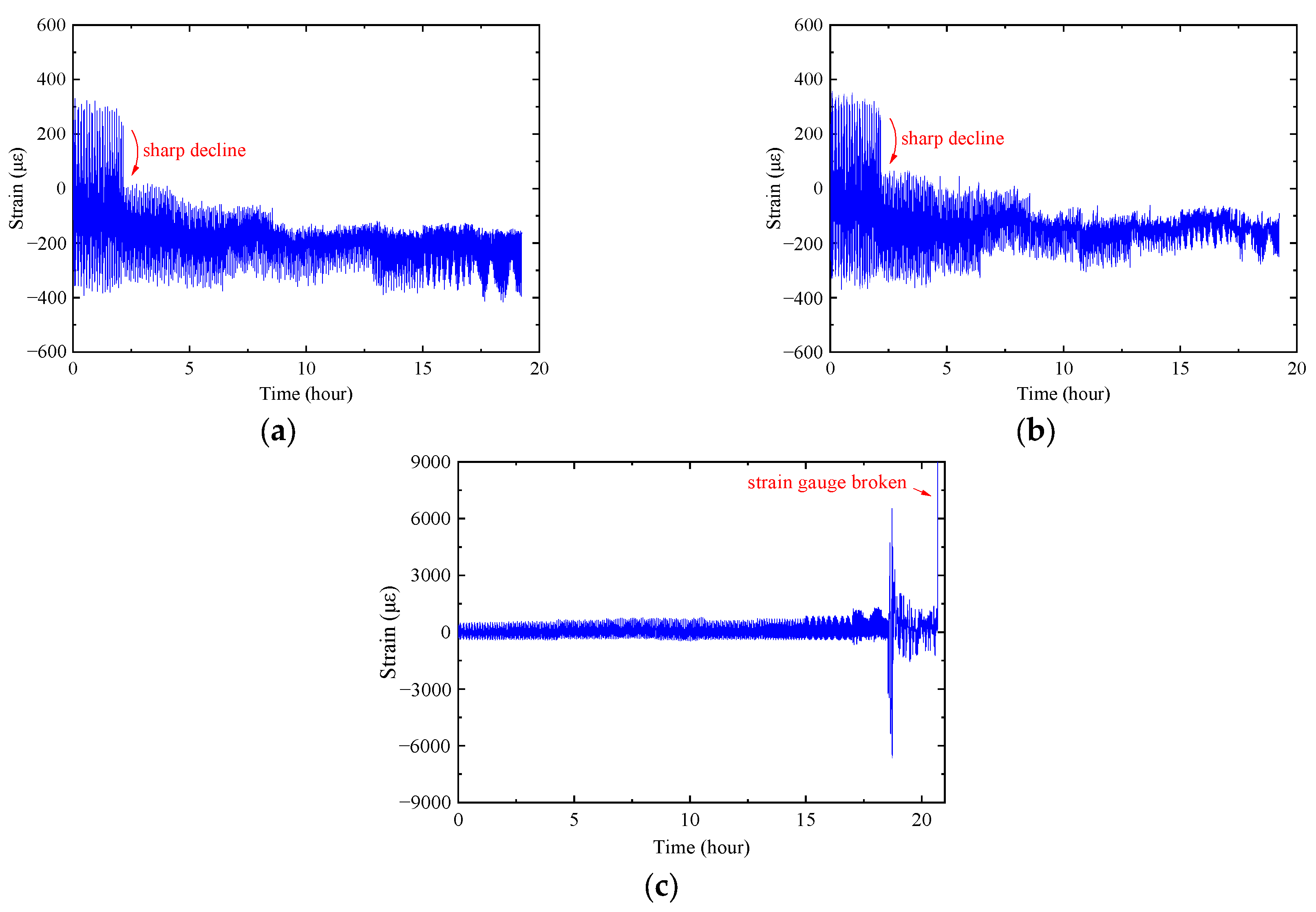

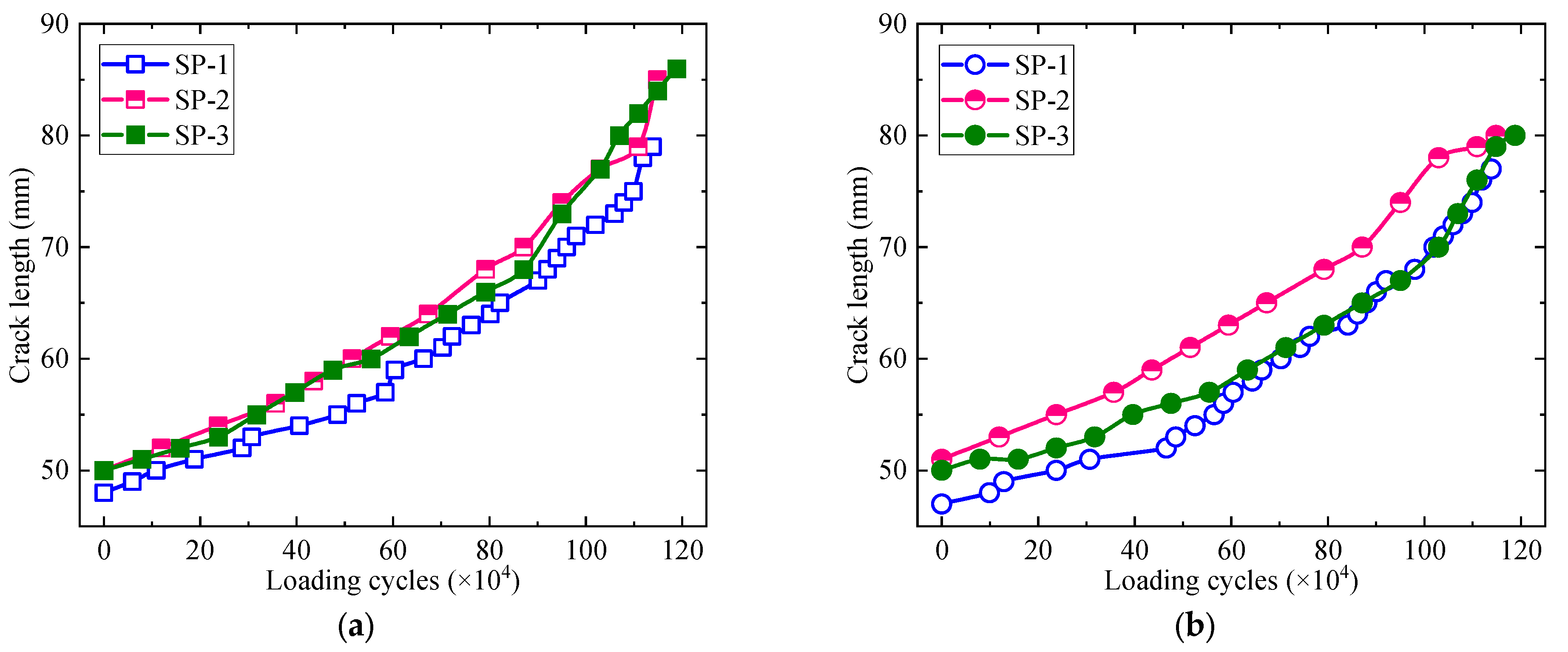
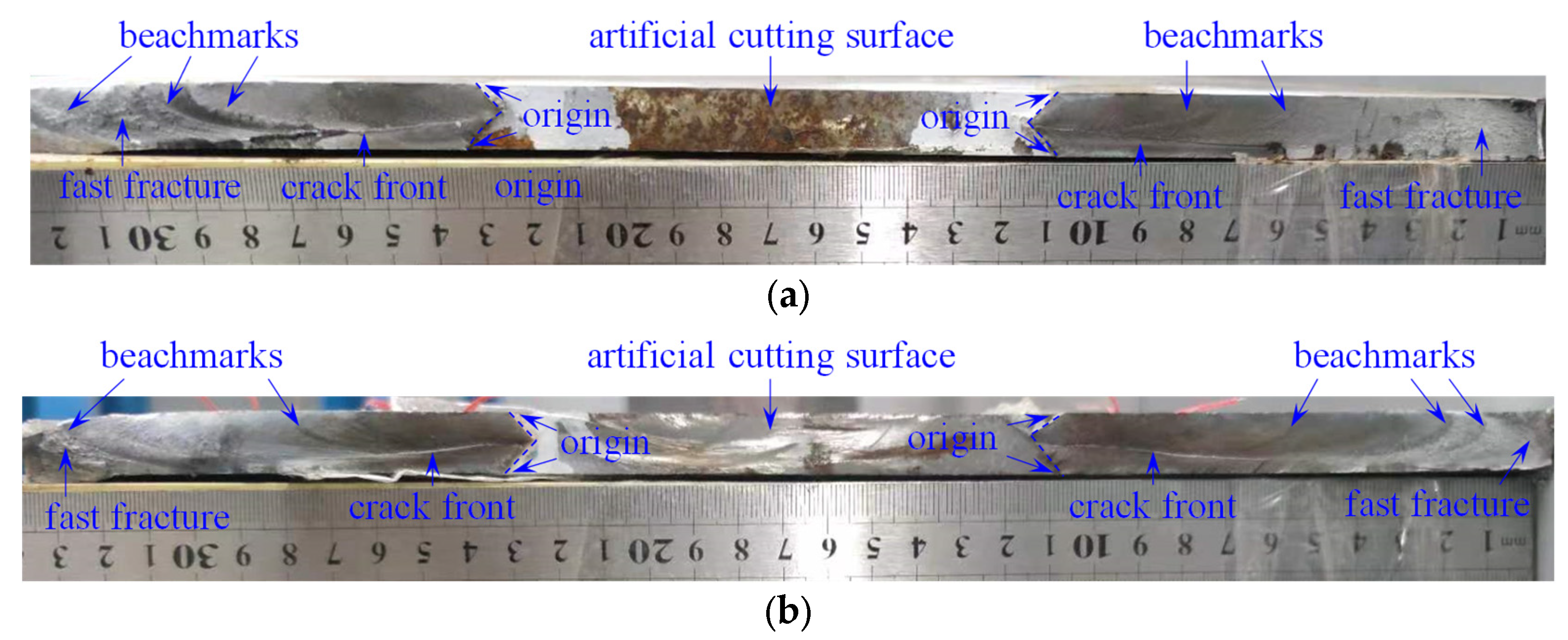
| Elastic Modulus (MPa) | Yield Strength (MPa) | Ultimate Tensile Strength (MPa) | Chemical Composition (%) | ||||
|---|---|---|---|---|---|---|---|
| 2.1 × 105 | 345 | 490 | C | Si | Mn | P | S |
| 0.14 | 0.31 | 1.46 | 0.016 | 0.006 | |||
| Elastic Modulus (MPa) | Yield Strength (MPa) | Ultimate Tensile Strength (MPa) | Chemical Composition (%) | ||||||
|---|---|---|---|---|---|---|---|---|---|
| 1.73 × 105 | 546 | 1015 | Cr | C | V | Si | Mn | Ni | S |
| 8 | ≤0.4 | ≤4 | 5 | 15 | 5 | 0.006 | |||
Disclaimer/Publisher’s Note: The statements, opinions and data contained in all publications are solely those of the individual author(s) and contributor(s) and not of MDPI and/or the editor(s). MDPI and/or the editor(s) disclaim responsibility for any injury to people or property resulting from any ideas, methods, instructions or products referred to in the content. |
© 2023 by the authors. Licensee MDPI, Basel, Switzerland. This article is an open access article distributed under the terms and conditions of the Creative Commons Attribution (CC BY) license (https://creativecommons.org/licenses/by/4.0/).
Share and Cite
Wang, Z.; Wang, L.; Wang, Q.; Ji, B.; Liu, J.; Yao, Y. Strengthening Cracked Steel Plates with Shape Memory Alloy Patches: Numerical and Experimental Investigations. Materials 2023, 16, 7259. https://doi.org/10.3390/ma16237259
Wang Z, Wang L, Wang Q, Ji B, Liu J, Yao Y. Strengthening Cracked Steel Plates with Shape Memory Alloy Patches: Numerical and Experimental Investigations. Materials. 2023; 16(23):7259. https://doi.org/10.3390/ma16237259
Chicago/Turabian StyleWang, Zhiqiang, Libin Wang, Qiudong Wang, Bohai Ji, Jie Liu, and Yue Yao. 2023. "Strengthening Cracked Steel Plates with Shape Memory Alloy Patches: Numerical and Experimental Investigations" Materials 16, no. 23: 7259. https://doi.org/10.3390/ma16237259
APA StyleWang, Z., Wang, L., Wang, Q., Ji, B., Liu, J., & Yao, Y. (2023). Strengthening Cracked Steel Plates with Shape Memory Alloy Patches: Numerical and Experimental Investigations. Materials, 16(23), 7259. https://doi.org/10.3390/ma16237259







